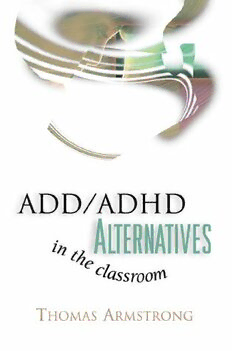
ADD ADHD Alternatives in the Classroom PDF
137 Pages·1999·0.673 MB·English
Most books are stored in the elastic cloud where traffic is expensive. For this reason, we have a limit on daily download.
Preview ADD ADHD Alternatives in the Classroom
Description:
What does it mean to a kid to be labeled attention-deficit disordered (ADD)? Or to have "hyperactive" added to the label (ADHD)? What can teachers do to boost the success of students with attention and behavioral difficulties? Are we relying too much on medication for these kids and not enough on new perspectives on learning, child development, the child's socioeconomic and cultural background, biological and psychological research, and the learner's emotional and social needs? Armstrong urges educators and parents to look for the positive characteristics in learners who may carry the ADD/ADHD label. Are they bursting with energy? Are they intensely creative? Do they enjoy hands-on learning? Are they natural leaders? Are they unusually introspective and reflective? We need to look beyond a "deficit" approach and embrace a more holistic view of learners that includes teaching to their multiple intelligences, learning styles, and other brain-friendly approaches. For example, here are some classroom activities for kids who "can't sit still": - Learning spelling words by having kids jump up out of their seats on the vowels and sit down on the consonants. - Mastering the multiplication tables by forming a conga line, moving around the classroom counting from 1 to 30 out loud, and on every multiple of 3 shaking their hips and legs. - Showing patterns of molecular bonding in chemistry class through a "swing your atom" square dance. Thomas Armstrong, an educator and psychologist from Sonoma County, California, has more than 26 years of teaching experience, from the primary through the doctoral level. He is the author of two other ASCD books, "Multiple Intelligences in the Classroom" and "Awakening Genius in the Classroom."
See more
The list of books you might like
Most books are stored in the elastic cloud where traffic is expensive. For this reason, we have a limit on daily download.
